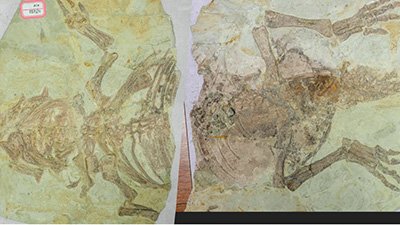
Another Evolutionary Flap
Last week we reported on a solid scientific study that dismissed dinosaur-to-bird evolution. Of course, some researchers have yet to catch on.
News Source
- BBC News: “New Dinosaur Gives Bird Wing Clue”
A new study in Nature tries to answer a question related to how dinosaur hands could have evolved into wing bones in modern birds. From “ancestral” species with five fingers, how could their descendants—other theropod dinosaurs (such as T. rex) and birds—end up with just three?
The question itself is steeped in evolutionary presuppositions, as even “seeing” evolution from five digits to three requires one first to assume evolution has happened. The same goes for imagining that three dinosaur fingers became the distinctly different wing bones in modern birds.
Nonetheless, the Nature study focuses on the discovery of a ceratosaur described as “primitive” (another presupposition-filled word), called Limusaurus inextricabilis. The fossil is missing a fifth digit, while the first is small and contains only one bone. To the reporting scientists, that suggests that ancient dinosaurs lost their first and last digit, with only the middle three surviving in later dinosaurs and birds.
There’s a problem, though. Because each digit contains a specific number of bones, other paleontologists have matched ancestral digits one, two, and three to the three existing digits in other dinosaurs. This fossil appears to be losing digits one and five—rather than four and five—which throws a wrench in that entire hypothesis.
The solution? “Identity shift,” which is described as “shifting patterns of gene expression from one limb or digit to another.” It sounds a bit too convenient to us, especially when the BBC notes that identity shift makes “the conflicting theories of bird hand origin suddenly align.” This is what identity shift is alleged to have allowed:
The third finger is made up of the four phalange bones that the second should have, and it is presumed that the second would lose one bone to become like the first finger that was missing in the fossil.
In this case, the more logical conclusion is that bird and dinosaur kinds were created uniquely for specific functions; this explains the significant differences in anatomy. One evolutionary presupposition seems to be that the Creator couldn’t have used the same number of digits on any two creatures. Without this presupposition, why would it seem strange to find the same number of digits on two creatures?
Also, within the kinds, it is possible that (through mutations, etc.) digits have been lost. Loss of digits (entirely or in part, as with the first digit of Limusaurus) would not prove evolution, but rather show the degenerative result of most mutations.
So, then, when the BBC says that this new fossil “appears to offer a snapshot of evolution,” it’s certainly correct in one sense. To those who assume evolution accounts for the gaps, the fossil can be inserted—thanks to the claim of historical “identity shift”—into a hypothesized (and imagined) lineage.
One other note: LiveScience reports that Limusaurus stood only 5 feet (1.5 m) from nose to tail-end. That reminds us that the average size of dinosaurs was probably similar to a large sheep or bison, posing no difficulty fitting representatives of the dinosaur kinds on the Ark.
Further Reading
- Did Dinosaurs Turn into Birds?
- What Really Happened to the Dinosaurs?
- 3.5 Vertebrates: Animals with Backbones
- Get Answers: Dinosaurs, Fossils
For More Information: Get Answers
Remember, if you see a news story that might merit some attention, let us know about it! (Note: if the story originates from the Associated Press, FOX News, MSNBC, the New York Times, or another major national media outlet, we will most likely have already heard about it.) And thanks to all of our readers who have submitted great news tips to us. If you didn’t catch all the latest News to Know, why not take a look to see what you’ve missed?
(Please note that links will take you directly to the source. Answers in Genesis is not responsible for content on the websites to which we refer. For more information, please see our Privacy Policy.)
Recommended Resources

Answers in Genesis is an apologetics ministry, dedicated to helping Christians defend their faith and proclaim the good news of Jesus Christ.
- Customer Service 800.778.3390
- Available Monday–Friday | 9 AM–5 PM ET
- © 2025 Answers in Genesis




